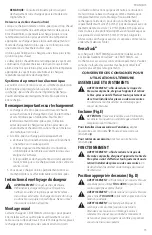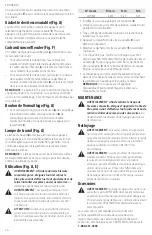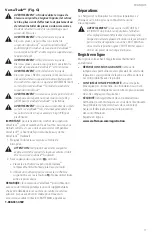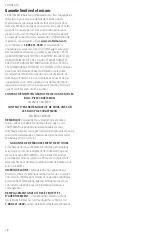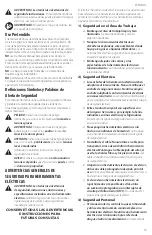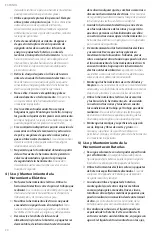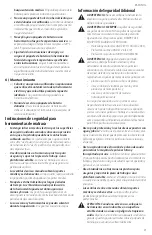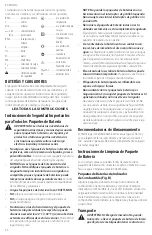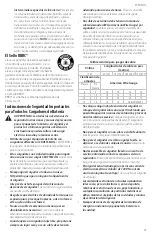
English
8
Accessories
WARNING:
Since accessories, other than those
offered by CRAFTSMAN,
have not been tested with
this product, use of such accessories with this tool
could be hazardous. To reduce the risk of injury, only
CRAFTSMAN recommended accessories should be used
with this product.
Recommended accessories for use with your tool are available
at extra cost from your local dealer or authorized service
center. If you need assistance in locating any accessory, please
contact CRAFTSMAN call
1‑888‑331‑4569
.
Cleaning
WARNING:
Blow dirt and dust out of all air vents with
clean, dry air at least once a week. To minimize the risk
of eye injury, always wear ANSI Z87.1 approved eye
protection when performing this procedure.
WARNING:
Never use solvents or other harsh
chemicals for cleaning the non‑metallic parts of the
tool. These chemicals may weaken the plastic materials
used in these parts. Use a cloth dampened only with
water and mild soap. Never let any liquid get inside the
tool; never immerse any part of the tool into a liquid.
MAINTENANCE
WARNING: To reduce the risk of serious personal
injury, turn unit off and remove the battery pack
before making any adjustments or removing/
installing attachments or accessories.
An
accidental start‑up can cause injury.
CAUTION:
Ensure fastener and/or system will
withstand the level of torque generated by the tool.
Excessive torque may cause breakage and possible
personal injury.
Cat #
RPM
Ft.‑lbs.
nm
CMCF930
0–300
0–35
0-47
1. Install appropriate accessory onto the anvil
2
.
2. Place the accessory on the fastener head. Keep the tool
pointed straight at the fastener.
3. Consider the intended operation and select either
forward or reverse rotation.
4. Press variable speed trigger switch
1
to start operation.
5. Release variable speed trigger switch
1
to stop operation.
6. If the ratchet stalls, the tool is overloaded or is being
improperly used. Release the variable speed trigger
switch
1
immediately. Do not press the variable speed
trigger switch
1
on and off in an attempt to start a
stalled ratchet. Doing so can damage the tool.
7. The ratchet can also be used manually for starting
stubborn fasteners or snugging by releasing the trigger
and applying the torque by hand.
nOTE:
Excessive manually applied torque may damage
the tool housing or mechanism.
Usage (Fig. A, E)
WARNING: To reduce the risk of serious personal
injury, turn unit off and remove the battery pack
before making any adjustments or removing/
installing attachments or accessories.
An
accidental start‑up can cause injury.
WARNING:
The ratchet may stall if overloaded causing
a sudden twist. Always expect the tool to twist. Grip the
ratchet firmly to control the twisting action and avoid
possible personal injury.
Worklight (Fig. A)
The worklight
6
is activated when the trigger switch is
depressed, and will automatically turn off 10 seconds after
the trigger switch is released. If the trigger switch remains
depressed, the worklight will remain on.
nOTE:
The worklight is for lighting the immediate work
surface and is not intended to be used as a flashlight.
Lock-off Button (Fig. A)
1. To lock the tool, slide the lock-off button
8
to the locked
position. When the lock-off button
8
is in the locked
position, the tool is locked and the trigger switch
1
cannot be pulled.
Variable Speed Trigger (Fig. A)
The tool is turned on and off by pulling and releasing the
variable speed trigger
1
. The farther the trigger is depressed,
the higher the speed of the tool. The anvil will stop as soon as
the trigger switch is fully released.
Forward/Reverse Dial (Fig. F)
A forward/reverse control dial
3
determines the rotational
direction of the tool.
• To select forward rotation (clockwise), release the trigger
and rotate the forward/reverse dial
3
on the head of
the tool in a counterclockwise direction.
• To select reverse rotation (counterclockwise), release
the trigger and rotate the forward/reverse dial
3
on the
head of the tool in a clockwise direction.
nOTE:
The first time the tool is run after changing the
direction of rotation, you may hear a click on start up. This is
normal and does not indicate a problem.
Proper Hand Position (Fig. D)
WARNING:
To reduce the risk of serious personal injury,
ALWAYS
use proper hand position as shown.
WARNING:
To reduce the risk of serious personal
injury,
ALWAYS
hold securely in anticipation of a
sudden reaction.
WARNING:
Ratchet may stall (if overloaded or
improperly used) causing a twist. Always expect the
stall. Grip the ratchet firmly to control the twisting
action and prevent loss of control which could cause
personal injury.
Proper hand position requires one hand on the main handle
7
as shown to control the twisting action of the ratchet.

















